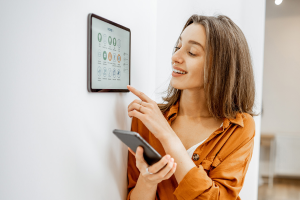Kids have been locking their diaries and hiding top secret shoe long before even Sandy Olssen had a crush on Danny Zuko. The need for more and more privacy as they mature is a natural part of growing up. Today, however, some kids hide their private lives behind locked decoy apps catapulting those harmless secret crushes to a whole new level. Looking for comprehensive mobile protection? Download McAfee Mobile Security.
A decoy app is what it sounds like; it’s a mobile app designed for the purpose of hiding something. Decoy apps are also called vault, secret, and ghost apps and make it tough for parents to know whether or not their kids are taking and sharing risky photos with peers since the apps are disguised as an everyday app.
A decoy app may look like a calculator, a game, or even a utilities icon, but it’s actually a place to tuck away content a phone user doesn’t want anyone to find. Kids use decoy apps to store screenshots of racy conversations, nude photos, pornographic videos, and party photos that are simply too risky to keep in a regular photo folder that mom or dad may find. One case in Pennsylvania documents vault apps at the center of sexting and cyberbullying case in a middle school.
Adults and Decoy Apps
Many adults are also well acquainted with decoy apps. It’s no surprise adults use these stealth apps to store private business activity, passwords to secret accounts, inappropriate photos, and content related to extramarital affairs. Apps such as Vaulty Stocks looks like a Wall Street stock market tracker, but in reality, it’s an app designed to keep private photos and videos hidden from nosey spouses.
How to Spot a Decoy App
If you want to get an idea of how many of these kinds of decoy apps exist go to your iOS or Android store app and search secret apps or decoy apps and you will get your fill of the many icons that are in place to hide someone’s private digital life.
Once you know to look for these apps designed to look like a calculator, a safe, a game, a note or even a shopping list app, you are well on your way.
A decoy app can’t be opened without a code or password specified by the original user. Some of these decoy apps such as Keep Safe Private Photo Vault actually have two layers of security (two passwords) designed to throw off a parent who can open the first level and find harmless content. According to the app description on the Google Play store, “Keepsafe secures personal photos and videos by locking them down with PIN protection, fingerprint authentication, and military-grade encryption. It’s the best place for hiding personal pictures and videos.” Further privacy is detailed with the promise of a face-down auto lock feature, “In a tight situation? Have Keepsafe lock itself when your device faces downward.” Another app, The Secret Calculator, description states: “Don’t worry about the icon. It will become a standard calculator icon. No one will ever notice.”
Other features highlighted in the Keepsafe app description include:
- Break-In Alerts: Takes photos of intruders and tracks break-in attempts
- Secret Door: Disguises your Keepsafe as another app
- Fake Pin: Creates a decoy Keepsafe with a separate PIN code
How to Discourage Decoy Apps
Connection first. Communication and a strong relationship with your child are the most cyber savvy tools you have to keep your child from making unwise choices online. So, take time each day to connect with your child. Understand what makes them tick, how they use technology, and what’s going on in their lives and hearts.
Monitoring. Weekly phone monitoring and using parental controls is always a good idea depending on the age of your child, your trust level, and the expectations that exist within your family. Know what apps your kids download.
Ask to Buy. Both Apple and Android have parental app purchase approval options on their websites you can set up to examine an app before it’s downloaded.
Get real. Talk candidly about the risks of sending, sharing, and even archiving risky photos on digital devices. Under the law, child pornography is considered to be any nude photograph or video of someone under the age of 18. It usually does not matter if the person possessing or distributing it is under the age of 18. Any offender can face fines and time behind bars. New laws that address juveniles caught possessing or distributing explicit photos are emerging every day and vary state by state.
Reality check. Nothing is private. Kids can share content directly from a decoy app, which means that their passcode is useless. Shared content is out of your hands forever. Sharing risky photos is never, ever a good idea.
It’s worth stressing to your kids that it’s not just about the technology you use, but how you use it that can create issues. None of the decoy apps we mentioned in this post are inherently “dangerous” apps, it’s the way the apps are used that make them unsafe for kids. The same mantra applies to social networks. And remember — give yourself grace as a parent. You can’t police your child’s online activity 24/7. It’s impossible. What you can do is educate yourself and know what these mobile apps do so you can address precarious situations that may come up. Looking for comprehensive mobile protection? Download McAfee Mobile Security.











